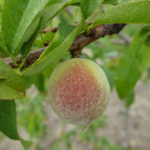Indiana Horticultural Society Field Day June 28, 2017 Tuttle Orchards 5717 North 300 West Greenfield IN 46140 Wednesday, June 28 9:00am-4:00 pm Joe Becovitz-Office of State Chemist: worker protection standards Fruit Production: tour of apple plantings including new orchards planted in 2014. Vegetable Production: tour of vegetable crop plantings, high tunnels, and chemical storage facilities.[Read More…]
Pears
We have not yet heard any reports of damage from spotted wing drosophila. Our short history with this pest is that damage will commence in early July. Growers should have their SWD traps in place now. Spraying should begin when the first SWD is caught in a trap or the first damage is observed. Because[Read More…]
Indiana Horticultural Society Field Day June 28, 2017 Tuttle Orchard Greenfield, IN More details to come but mark the date on your calendar and plan to attend Indiana Winery and Vineyard Association Summer Meeting and Vineyard Tour July 18-19, 2017 Brown County Inn, Nashville IN More details to come, but mark the date on your calendar[Read More…]
The Office of the Indiana State Chemist has filed a Notice of Intent to Adopt a New Rule that will make most dicamba containing herbicides Restricted Use Products (RUP). This designation will allow the OISC to track sales of those herbicides. As many specialty crop growers know, dicamba is one of the growth regulator herbicides[Read More…]
WASHINGTON, Mar. 15, 2017 –America’s farmers and ranchers will soon have the opportunity to strongly represent agriculture in their communities and industry by taking part in the 2017 Census of Agriculture. Conducted every five years by the U.S. Department of Agriculture’s (USDA) National Agricultural Statistics Service (NASS), the census, to be mailed at the end[Read More…]
Eastern Indiana Fruit Growers Association Hosting Orchard Garden tours at the “Slice of Paradise” 3912 S. Felton St., Marion, IN. Tuesday, May 23 at 6:30pm Dr. Rick Foster from Purdue University will be in attendance For more information, call 765-661-4597 Indiana Horticultural Society Field Day June 28, 2017 Tuttle Orchard Greenfield, IN More details to come but[Read More…]
Grapes have grown quickly this past week and most varieties are now past bud burst. The earliest have 4 to 6 inch shoots at this time. Blackberries and raspberries are also growing rapidly, with new primocanes emerging from the ground and laterals on floricanes out to 4 inches or longer. Flower buds are visible on[Read More…]
Codling moths are flying in some parts of the state. Place your pheromone traps in the orchard during bloom. I have not yet caught any in my traps but expect to soon. We define biofix as the first sustained flight of moths. Therefore, we don’t determine biofix when that first moth shows up in the[Read More…]


